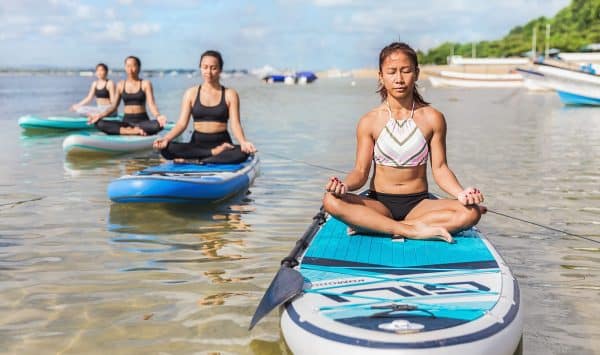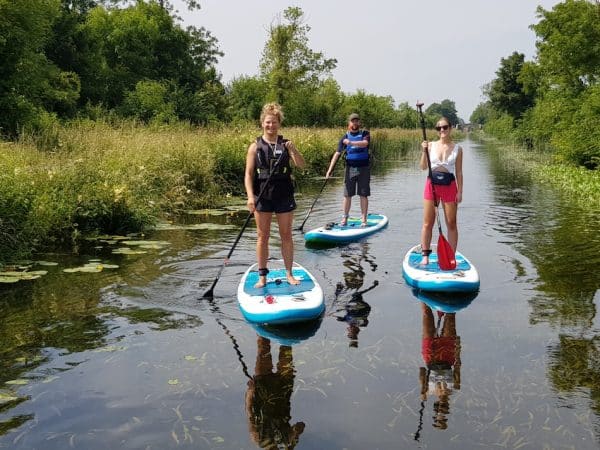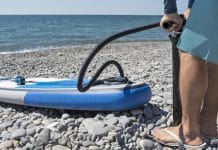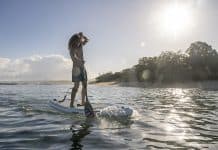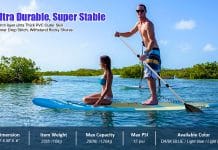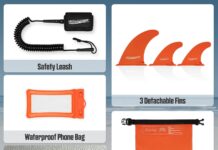We’ve discovered a little secret: paddle boarding is not just about gliding on water or enjoying the scenery. It’s also about choosing whether to wear shoes or go barefoot. Surprising, right?
This article will take you on a journey to find the perfect footwear for your paddleboard adventure. So, get ready to take the plunge and discover the shoe dilemma that awaits you in the paddle boarding world.
Review contents
Benefits of Wearing Shoes
Paddle boarding is a thrilling water sport that allows us to explore the beauty of the water while simultaneously giving our bodies a great workout. While some paddle boarders choose to dive into this activity barefoot, numerous benefits come with wearing shoes.
Here, we will discuss some advantages of wearing shoes while paddle boarding, including protection from rocks and debris, improved grip on the paddle board, preventing slippery surfaces, and extra foot support and balance.
Protection from Rocks and Debris
One of the primary benefits of wearing shoes while paddle boarding is their protection against rocks and debris. Hidden dangers may lurk beneath the surface as we traverse through the water. Sharp rocks, shells, or even broken glass can pose a potential hazard to our feet. Wearing shoes with sturdy soles is a barrier, shielding our feet from these potentially harmful objects. This additional layer of protection allows us to enjoy our paddle-boarding experience with peace of mind.
Improved Grip on the Paddle Board
Maintaining a good grip on the paddle board is crucial to ensure stability and control while navigating through the water. Wearing shoes specifically designed for paddle boarding significantly improves our grip on the board’s surface. The specially designed outsoles of paddle boarding shoes offer excellent traction, allowing us to maintain a firm foothold on the board. This enhanced grip increases our overall performance and reduces the risk of slipping and falling, especially during tricky maneuvers or changing water conditions.
Prevention of Slippery Surfaces
Along with providing improved grip on the paddle board, wearing shoes also helps prevent slipping on wet or slippery surfaces. The damp surface can quickly become a potential slip zone, whether water splashing onto the board or a sudden rain shower. Shoes with slip-resistant soles come to the rescue, offering us stability and security even on wet surfaces. This ensures we can confidently engage in our paddle-boarding adventure without worrying about accidental slips or falls.
Extra Foot Support and Balance
Another advantage of wearing shoes during paddle boarding sessions is their added foot support and balance. Paddleboarding requires us to maintain a stable stance and engage multiple muscle groups for balance and control. Shoes with a supportive arch and cushioning help distribute our body weight more evenly, taking the strain off our feet and minimizing the risk of fatigue or foot-related injuries. Additionally, the snug fit of paddle boarding shoes ensures a secure grip on our feet, allowing us to focus on enjoying the ride without constantly readjusting our foot position.
Types of Shoes for Paddle Boarding
Now that we understand the benefits of wearing shoes while paddle boarding, let’s explore the different types of shoes specifically designed for this exciting water sport. Each type of shoe offers unique features and benefits, catering to different preferences and water conditions.
Water Shoes
Water shoes are popular among paddle boarders due to their versatility and functionality. Designed to be lightweight and quick-drying, water shoes are perfect for navigating both in and out of the water. They provide excellent traction, protection, and breathability, making them suitable for various paddle-boarding environments. Water shoes often feature mesh uppers that allow water to drain quickly, preventing them from becoming waterlogged. These shoes are a fantastic option for those who want a comfortable, versatile shoe that can handle different terrains and water conditions.
Wet Boots
Wet boots are excellent for paddle boarders who prefer additional ankle support and protection. These boots have a higher top, offering extra coverage to our ankles and helping to prevent injuries caused by accidental twists or impacts. Wet boots also provide insulation, ideal for colder water conditions or paddle boarding in the cooler months. While wet boots may take longer to dry compared to other shoe types, they provide enhanced foot support and protection, making them a preferred option for adventurous paddle boarders seeking maximum safety and stability.
Neoprene Socks
Neoprene socks are another option to consider when choosing shoes for paddle boarding. These socks are made from neoprene, providing insulation and protecting our feet from cold water temperatures. Neoprene socks are lightweight and flexible, allowing us to maintain a natural feel for the board while providing some foot support. They are an excellent choice for those who prefer minimal footwear or desire the convenience of easy storage and transport.
Sandals or Flip Flops
Sandals or flip-flops can be suitable for paddleboarders seeking a more casual and relaxed footwear option. While these shoes may not offer as much foot protection or support as water shoes, wet boots, or neoprene socks, they provide breathability and easy slip-on/off convenience. Sandals or flip-flops with sturdy soles and good traction can offer some grip and protection against rocks and debris. However, it is essential to consider their potential to come off or become loose during vigorous movements, which could hinder our overall paddle-boarding experience.
This image is the property of cdn.shopify.com.
Considerations for Choosing Paddle Boarding Shoes
When selecting the right pair of shoes for paddle boarding, we must consider several factors to ensure we choose the shoes that best meet our needs and preferences.
Fit and Comfort
Fit and comfort should be at the top of our list when choosing paddle-boarding shoes. Ill-fitting shoes can cause discomfort, blisters, or even foot injuries. Trying on different pairs and determining the correct size for our feet is crucial. The shoes should have a snug fit to prevent slipping but shouldn’t be too tight to restrict blood circulation. Additionally, considering any unique foot characteristics or conditions, such as high arches or wide feet, will help us find shoes that provide the proper support and comfort.
Drainage and Quick Drying
Since we will be in and around water while paddle boarding, shoes with efficient drainage and quick-drying capabilities are essential; look for shoes with mesh uppers or open designs that allow moisture to escape freely, preventing the formation of water pools within the boots. Additionally, materials such as neoprene are known for their quick-drying properties and can be an excellent choice for paddle boarding shoes. Opting for shoes that dry quickly will keep our feet comfortable and prevent moisture buildup, which can lead to unpleasant odors or fungal infections.
Grip and Traction
As mentioned earlier, having a good grip on the paddle board is crucial for stability and control. When choosing paddle boarding shoes, we should prioritize those with excellent grip and traction. Look for shoes with outsoles that provide superior traction on wet or slippery surfaces. Deep treads, specialized rubber compounds, or even built-in grooves can significantly enhance grip, allowing us to maintain balance and prevent accidental slips or falls.
Quality and Durability
Lastly, we should consider the quality and durability of our paddle-boarding shoes. Paddleboarding can be rigorous, subjecting our shoes to constant wear and tear. Investing in high-quality shoes built to last will ensure they withstand the demanding conditions associated with paddle boarding. Look for shoes made with durable materials, reinforced stitching, and sturdy outsoles that can withstand prolonged exposure to water and rough terrains.
Pros and Cons of Wearing Shoes
Now that we have explored the benefits of wearing shoes while paddle boarding and discussed different types of shoes suitable for this water sport, let’s analyze the pros and cons of wearing shoes.
Advantages of Wearing Shoes
They are wearing shoes, while paddle boarding offers numerous advantages. As mentioned earlier, shoes protect against rocks, debris, and potential sharp objects. They also provide improved grip on the paddle board, helping maintain stability and control. Shoes add an extra layer of safety by preventing slips on slippery surfaces, reducing the risk of injury. Furthermore, wearing shoes with good foot support and balance promotes better posture and reduces strain on our feet, legs, and joints.
Disadvantages of Wearing Shoes
While there are many benefits to wearing shoes while paddle boarding, there are also a few disadvantages to consider. Some paddleboarders argue that shoes can limit the “connection” or “feel” between their feet and the board.
They claim that going barefoot allows for a more natural and intuitive experience, enhancing their connection with the water and their board. Additionally, shoes not correctly fitted or made of subpar-quality materials may cause discomfort or hinder movement.
It’s essential to find the right balance between the advantages and disadvantages, taking into account personal preferences and the specific paddle boarding conditions we will encounter.
This image is the property of www.academyofsurfing.com.
Tips for Paddle Boarding Without Shoes
For those adventurous paddle boarders who choose to go shoeless, there are several tips to consider to ensure a pleasant and safe experience on the water.
Foot Preparation and Toughening
To prepare our feet for the rigors of paddle boarding without shoes, gradually exposing them to different surfaces and conditions is essential. Start walking barefoot on sand, grass, or soft surfaces to help toughen your feet and build up resistance.
As we become more comfortable, we can gradually introduce harder and rougher surfaces, like pebbles or rocks. This gradual exposure will help our feet develop thickened skin and calluses, providing natural protection when paddle boarding without shoes.
Picking the Right Time and Location
Choosing the right time and location is crucial when paddle boarding without shoes. Opt for calm waters with minimal waves or currents, as rougher conditions can increase the likelihood of getting feet swept by water or injured by rocks.
Additionally, paddle boarding during warmer months or locations with warmer water temperatures will help prevent discomfort caused by cold water on bare feet. Assess the conditions carefully and select a suitable time and location to maximize enjoyment and minimize potential hazards.
Avoiding Rocks and Debris
When paddle boarding without shoes, we must pay extra attention to our surroundings to avoid rocks and debris. Scan the water surface and plan our route accordingly, steering clear of areas with known hazards. Be alert for potential objects floating beneath the water’s surface, and adjust your paddle strokes or stance to avoid them. By remaining vigilant and paddling consciously, we can significantly reduce the risk of foot injuries when paddle boarding barefoot.
Using Wax or Traction Pads
For paddle boarders who prefer to go without shoes, wax or traction pads on the board’s surface can provide additional grip and traction. Applying surf wax or traction pads designed explicitly for paddle boards can enhance foot grip and prevent slipping.
These accessories can help mimic the advantages of wearing shoes, offering extra protection and stability for bare feet. However, it’s important to periodically check the wax or traction pads for wear and tear, as worn-out grip materials can be less effective and potentially pose a hazard.
Hygiene and Safety Considerations
Whether we wear shoes or go barefoot while paddle boarding, there are essential hygiene and safety considerations to remember to ensure an enjoyable and safe experience.
Fungal Infections and Hygiene
Spending prolonged periods in and around water increases the risk of fungal infections, particularly on the feet. To prevent such infections, it’s essential to maintain good foot hygiene. Thoroughly clean and dry our feet after every paddle boarding session, paying particular attention to the areas between the toes.
Using antifungal sprays or powders can also help prevent fungal growth. If wearing shoes, ensure they have proper drainage and quick-drying capabilities to minimize moisture buildup. Making foot hygiene a priority will help keep our feet healthy and prevent discomfort or infections.
Protection from Sharp Objects
Whether we choose to wear shoes or not, it’s essential to protect our feet from sharp objects that may be present in or around the water. When paddle boarding in unfamiliar areas, it’s best to assume that potential hazards may lurk beneath the surface.
Avoid areas with sharp rocks, shells, or broken glass where possible. If navigating through rocky areas is unavoidable, extra preventive measures such as wearing shoes or using a foot protection accessory can significantly reduce the risk of foot injuries.
Sunburn and Heat
Paddleboarding often occurs under the sun, exposing our feet to sunburn risk. Apply sunscreen to all exposed areas of our feet to protect them from harmful UV rays. Additionally, the sun can heat the board and make its surface unbearably hot to walk on.
If the board becomes too hot to touch, have a towel or other protective gear on hand to shield our feet from the scorching surface. Like any outdoor activity, staying hydrated and taking regular breaks in shaded areas will help prevent overheating and keep our feet comfortable.
This image is the property of supboardermag.com.
Conclusion
Whether we wear shoes or go shoeless while paddle boarding, there are benefits, considerations, and precautions to keep in mind: shoes offer protection from rocks and debris, improved grip on the paddle board, prevention of slippery surfaces, and extra foot support and balance.
Various types of shoes, including water shoes, wet boots, neoprene socks, and sandals or flip flops, cater to different paddle-boarding preferences and environments. Factors such as fit and comfort, drainage and quick drying, grip and traction, and quality and durability should be considered when choosing paddle boarding shoes.
Weighing the pros and cons of wearing shoes and following the tips for paddle boarding without shoes will ensure an enjoyable and safe experience on the water.
Lastly, practicing good hygiene, protecting feet from sharp objects, and being mindful of sunburn and heat will contribute to maintaining foot health and overall well-being during our paddle boarding adventures. So, let’s gear up, put on our preferred footwear, and dive into the thrilling world of paddle boarding!


